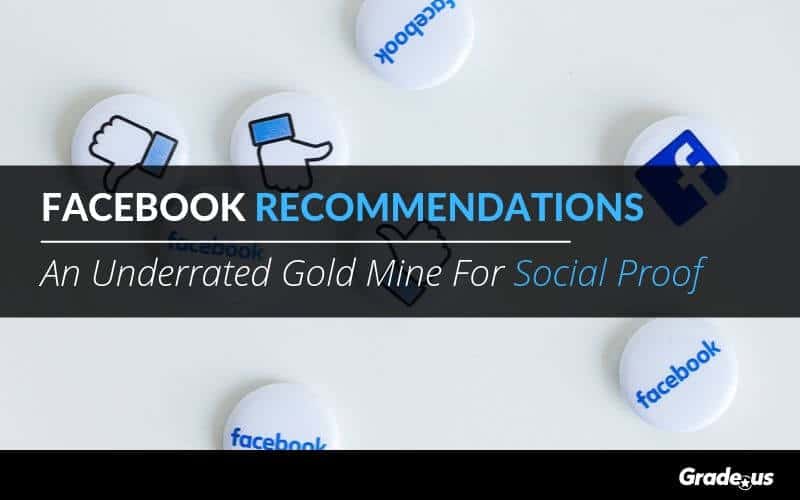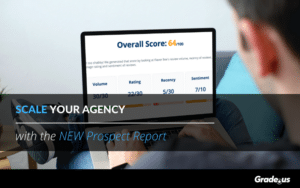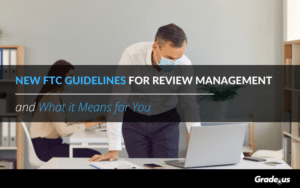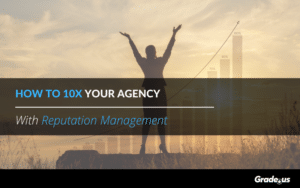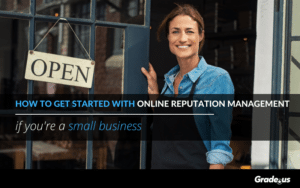How important is it to get Facebook recommendations? Can Facebook recommendations go viral?
One out of every three Facebook users, or approximately 800 million people, use their platform for reviews and recommendations. Additionally, two out of three users, about 1.6 billion people, visit the page of a local business every week.
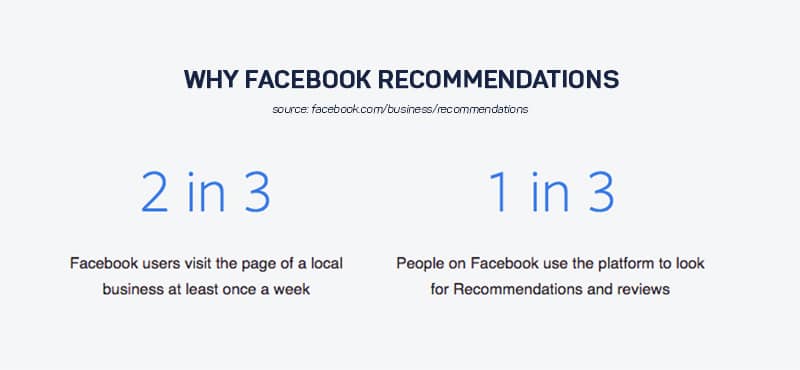
So why aren’t more brands using recommendations?
At this point, most local brands use recommendations accidentally – their customers take the initiative and post a positive (or negative) recommendation on their own. It’s a consumer-driven phenomenon that should be brand-driven.
Why?
Because of virality. With the right approach, positive recommendations can spread like wildfire, boosting the traffic, leads, and sales to your business.
Here’s what we’ll cover today:
Table of Contents
Get the Reputation You Deserve with Grade.us
Let’s get started.
Why are Facebook recommendations important to your business?
Here’s how Facebook describes it:
“Recommendations: Your customers are your best ambassadors. When people look for places to eat, shop, or book a service, they often ask their friends and families where to go. That’s why we’re making it easier for people to recommend your business by bringing Recommendations to your Page. People will now be able to post a recommendation for your business, including text, photos, and tags directly on your Page. And recommendations will also help you reach people while they’re searching for or talking about your business.”
They’re talking about reviews.
Almost a billion people rely on Facebook for local search and review recommendations. If you’re a local business, your customers rely on Facebook for person-to-person recommendations. Are these engaged users? Let’s take a look at Facebook’s engagement benchmarks.
- 3.60% average engagement rate across all post types
- 6.13% average engagement across video posts
- 4.49% average engagement across photo posts
- 2.91% average engagement across link posts
- 1.82% average engagement across page status posts
Is this engagement consistent across the site for each page?
That depends.
- Pages with 10,000 fans or less have a higher average organic page post reach (8.29%) vs. page likes (4.73%)
- Pages with more than 100,000 fans have a lower average organic page post reach (2.98%) vs. page likes (2.67%)
Are pages with more fans less engaging?
Not at all.
It’s simply the way Facebook chooses to divvy up its organic reach. Here are a few examples showing why Facebook Recommendations are so important to your business.
Restaurants
Simon & Seafort’s restaurant is an Alaskan favorite. Their restaurant is a local favorite, and they’re eager to engage with customers who leave positive or negative recommendations.
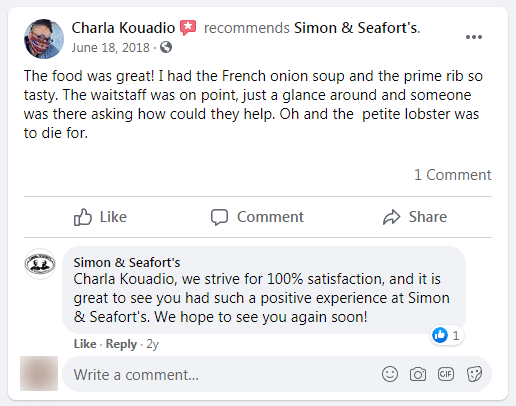
Home Services
Mr. Electric is a well-known provider in the U.S., Canada, UK, Spain, Portugal, and Australia. They have 250 locations, and they take care of their customers whether they’re happy or not.
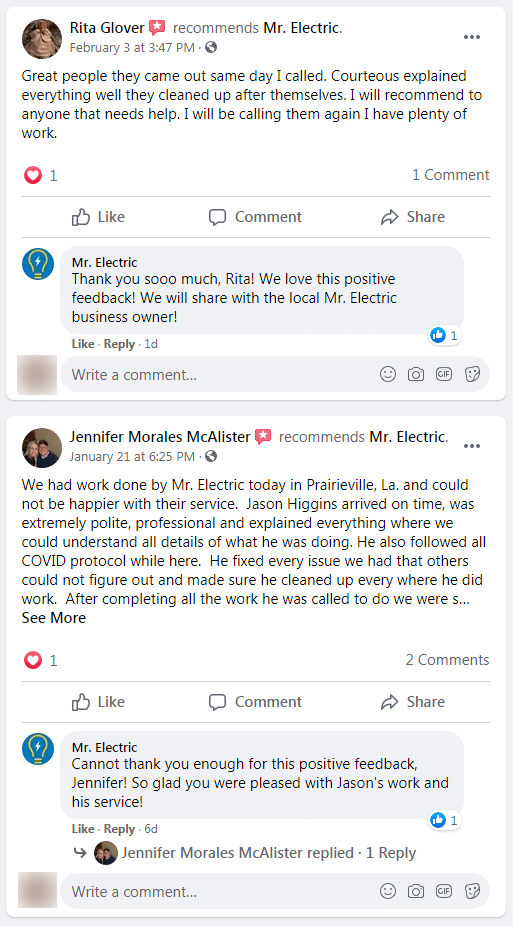
Doctors
Central Virginia Family Physicians received a negative review from an unhappy patient. These reviews are significant because they continue to have a life of their own over time. The more engagement these posts receive, the more visible they continue to be, amplifying the damage done to these establishments.
This clinic responded defensively, increasing the damage of this post.
Optics are important here.
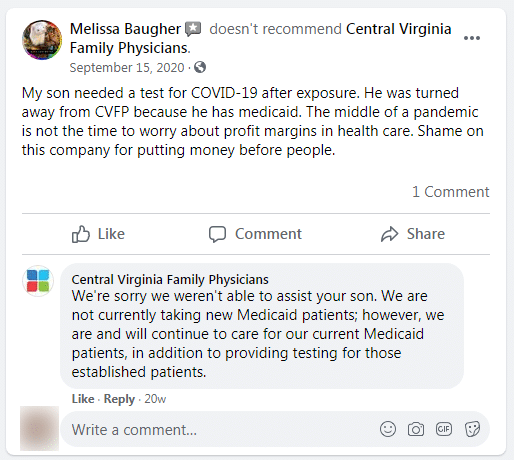
Real estate agents
Ross Realty spends a significant amount of time with their clients. According to this reviewer, she received “First class/White glove” treatment, selling her elderly father’s home quickly.
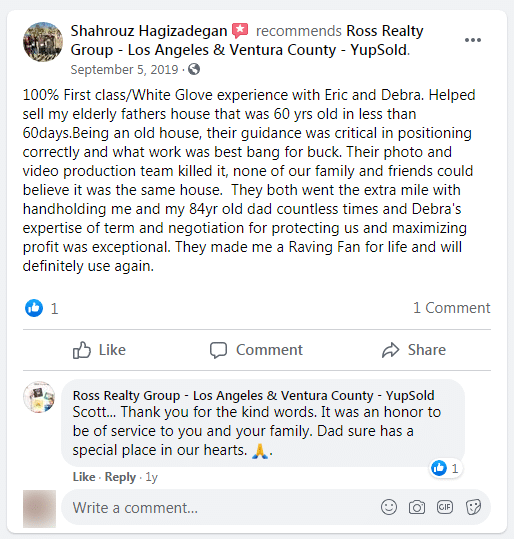
See the significance of Facebook Recommendations?
It’s virality.
The more reviews you receive, the more value (or harm) you experience. Likes, comments, and shares extend the life of each recommendation, keeping things active over time.
Facebook Reviews are now Facebook Recommendations
In August of 2018, Facebook changed from a 5-star review rating system to the binary options of “recommended” or “not recommended.”
“Recommendations: Your customers are your best ambassadors. When people look for places to eat, shop or book a service they often ask their friends and families where to go. That’s why we’re making it easier for people to recommend your business by bringing Recommendations to your Page. People will now be able to post a Recommendation for your business including text, photos, and tags directly on your Page. And Recommendations will also help you reach people while they’re searching for or talking about your business.”
This is why your business needs Facebook recommendations. If you’re a local, regional or national brand, recommendations are crucial. If you’re running a B2C firm, Facebook recommendations are indispensable.
as seen here:
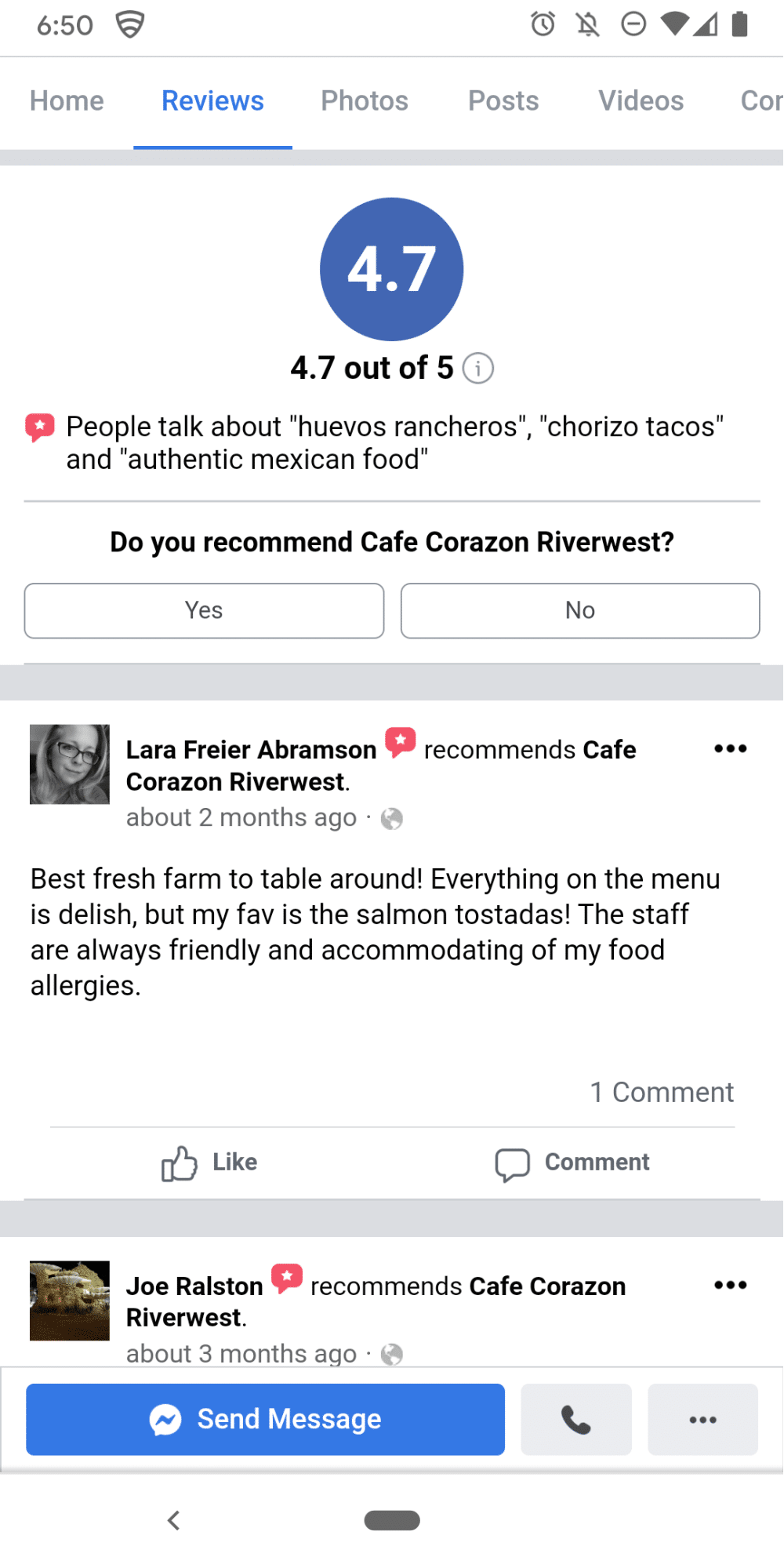
Facebook also added Rich Endorsements.
Sometimes, people don’t know what to write in their reviews. With the move to recommendations, it’s helpful to receive prompts on what to write. A simple recommendation or non-recommendation isn’t useful for other friends or potential customers.
To avoid ’empty recommendations,’ Facebook has added prompted attributes that they’re referring to as ‘Rich Endorsements’ to include in the recommendations. So far, we only see this for restaurants and coffee shops, but we can expect them to roll these endorsements to other industries.
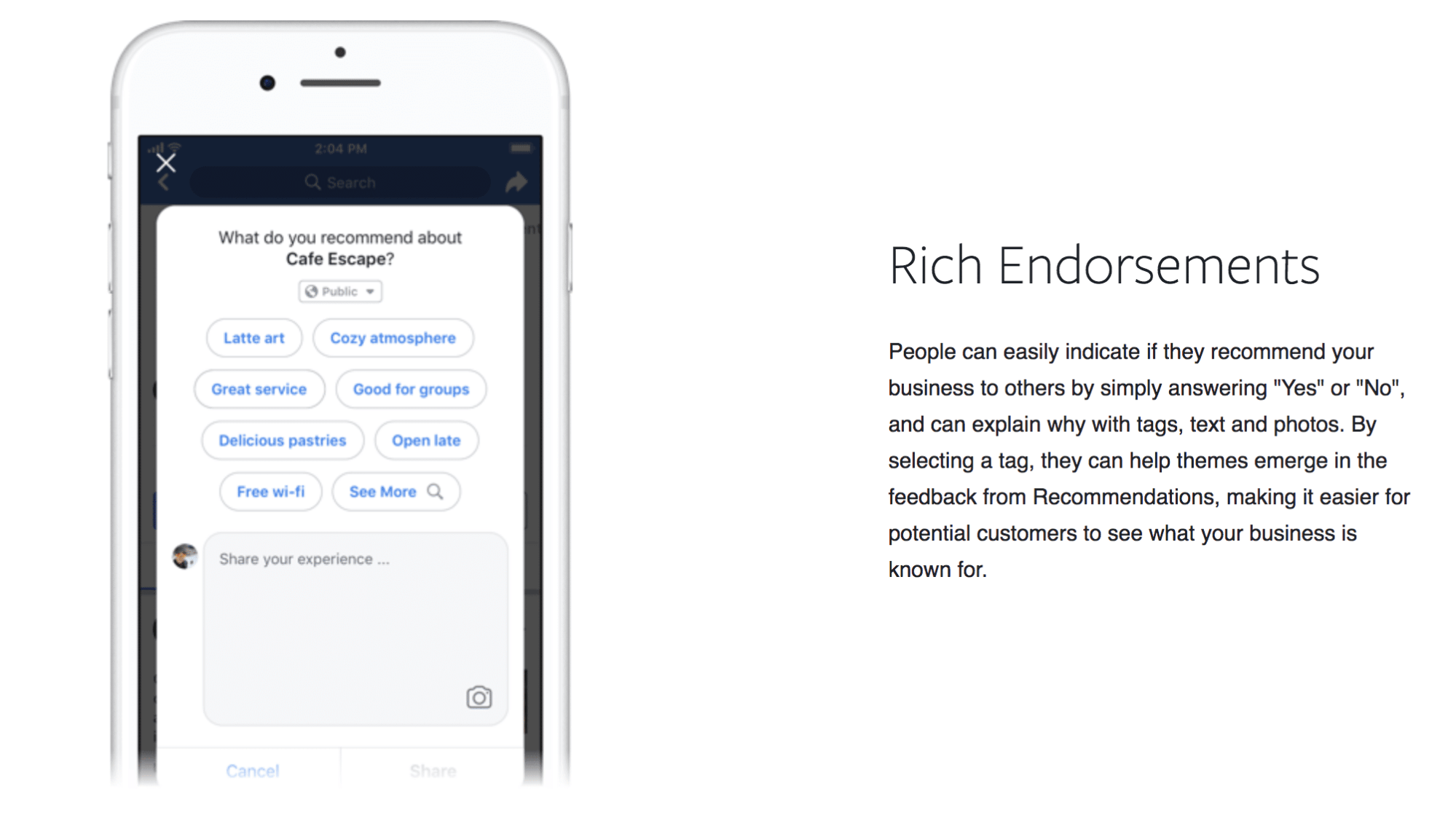
Business goals for local businesses on Facebook
Facebook is a versatile platform.
They offer more than 40 different products and services to their users. Brand goals on Facebook are pretty much what you’d expect on other review platforms, with a few atypical goals added to the mix.
- Branding: Research shows display advertising increases search activity in Google. Display ads are often used to increase brand awareness and brand trust, so it’s no surprise that this increases curiosity from interested searchers. Facebook ads, when combined with reviews and retargeting, provide significant direct and indirect benefits.
- Bookings: Facebook offers brands a free scheduling tool they can use to attract and set appointments for their business. Their offering starts with a “Book Now” button and extends into appointment and availability management, reminders, and service listings.
- Footfalls: Offline customer foot traffic directly from your Facebook page to your physical location. This could be customers stopping by to redeem a voucher, requesting more information, or visiting your business for the first time to get a sense of what you’re about.
- Leads: This isn’t just customers’ contact info. It’s contact information from motivated prospects, people who are both willing and able to buy. The majority of sellers on Facebook are inexperienced and subject to Facebook’s inexperience tax. They treat lead gen as a direct response affair when in reality, it’s similar to a CPM model. Customers on Facebook need to be wooed. The direct approach is typically not the most effective.
- Online visits: This refers to traffic from your Facebook page driven to a website or landing page you control. Achieving conversions with these visits requires (a.) precise targeting and matching (b.) a compelling offer, (c.) strong ad scent, and (d.) warming up cold traffic.
- Sales: Customer derived cash flow. You provide customers with the outcomes (results, experience, solution, delight, etc.) they’re looking for in exchange for money. A strong review portfolio directly correlates to increased sales and revenue.
You know your business.
You also have a good understanding of the goals that best fit your business – leads for service providers, sales for local storefronts, bookings for specialty services, e.g., accounting, haircuts, home services, etc.
If you need more help getting started, Sendible has 8 Facebook tips for businesses.
Okay then.
You have a good sense of the goals you’re pursuing in business.
Where do you start?
Setting up recommendations for Facebook
First things first, you’re going to need a Facebook Business page.
I’m going to assume that you already have a Facebook page set up and ready to go. If you don’t have one in place already, here’s a full tutorial complete with expert tips, strategies, and tactics. This video will walk you through all of the settings required to set your profile up properly.
- On your Facebook page, on the left sidebar, click “Settings. “
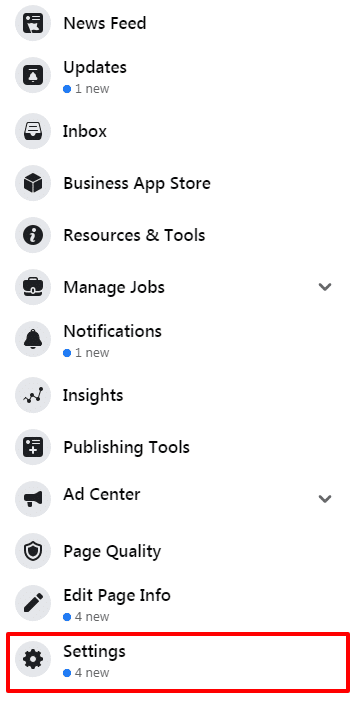
- On your settings page, on the left sidebar, click “Templates and Tabs. “
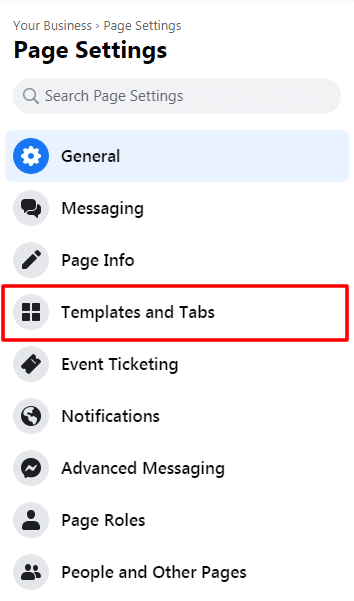
- Scroll to the “Tabs.” section. Under “Reviews,” click the button to toggle this tab on and off. Click and drag a tab name to rearrange the order.”
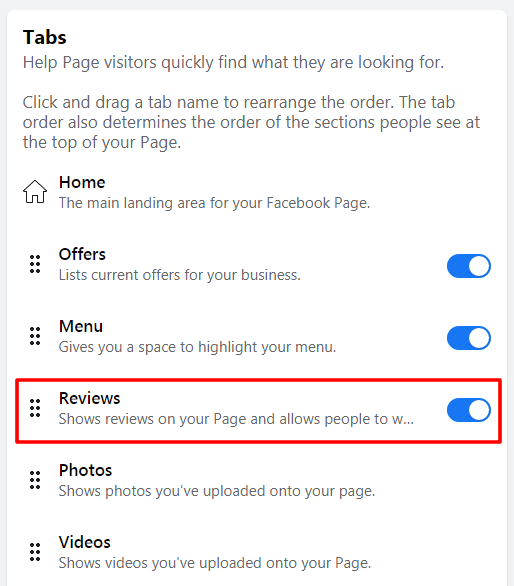
- If you’ve reordered your tabs, you should see “Reviews” in your page menu.
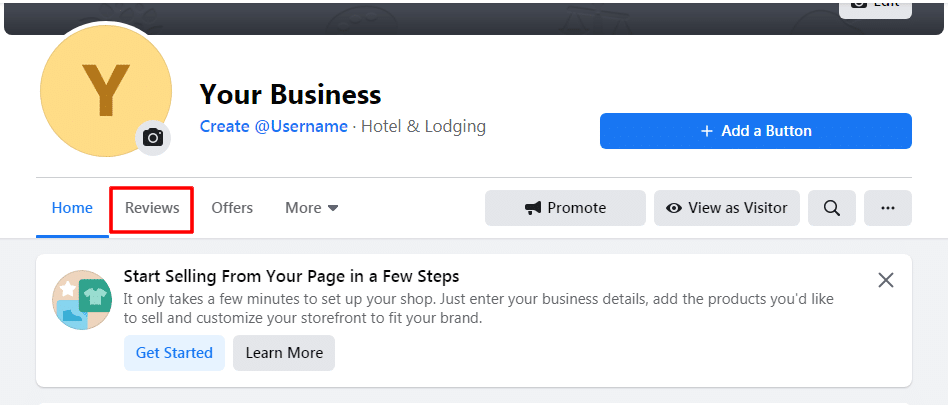
And that’s it!
What about reviewers? What will they see?
Reviewers will be asked “Do You Recommend ____?” along with a “Yes” or “No option.” If reviewers answer yes, they’ll be encouraged to add tags, photos, and additional information in their recommendation. If their answer is No, reviewers will be encouraged to share additional information.
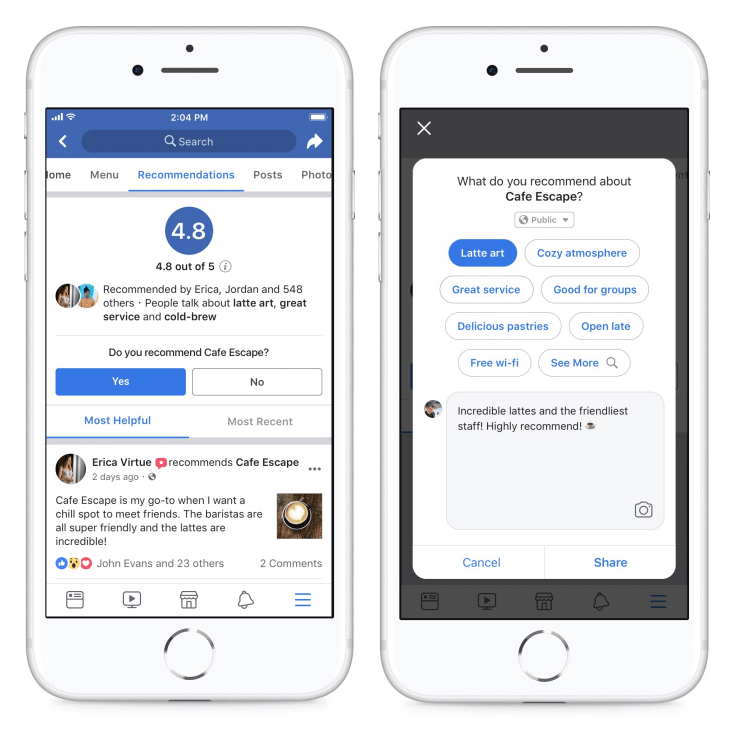
As far as review platforms go, these steps are fairly straightforward. What’s not straightforward is optimizing customer feedback to maximize virality.
How do you do it?
Optimizing recommendations on Facebook
Optimizing customer recommendations is the first step in inducing virality. I covered this briefly in a previous post on Facebook recommendations.
Facebook has built-in virality.
To recap, this virality expresses itself in three distinct ways.
- Information cascade refers to herd behavior, where one person’s decisions impact the future choices of others. For example, a popular restaurant will have an easier time attracting new customers as more people will choose to eat there due to their popularity.
- Keeping up with the Joneses: It’s an idiom we’ve heard before. People compare themselves to one another using opportunity, privilege, access, and the accumulation of material goods as a benchmark for social class.
- The Gini Coefficient is an index that measures the amount of income inequality for a particular area. The Gini Coefficient measures material wealth relative to others in a particular area or sphere. Research from the Federal Reserve Bank of Philadelphia found neighbors of lottery winners felt social pressure to compete with winners.
What does this mean?
Recommendations amplify these social components in a given direction, depending on whether the recommendations you receive are positive or negative.
Why is this important?
There’s a formula for virality. Jonah Berger and Katherine Milkman, researchers at the University of Pennsylvania, shared their now-famous paper entitled “What makes online content viral? “
Their discovery is fascinating.
It’s not just about valence – the quality of emotion (e.g., anger = negative valence, joy = positive valence, etc.), that makes the difference. When it comes to virality, activation is the key to success.
What does this mean?
Well, anger, fear, and sadness are all characterized as negative emotions. But we don’t respond to them the same way. Anger and fear create a heightened state of arousal or activation. Sadness does the opposite; it decreases arousal, acting as a deactivator of sorts.
Here’s a quote from their paper.
“Anger, anxiety, and sadness are all negative emotions, for example, but while anger and anxiety are characterized by states of heightened arousal or activation, sadness is characterized by low arousal or deactivation (Barrett and Russell 1998).
We suggest that these differences in arousal shape social transmission (see also Berger 2011). Arousal is a state of mobilization. While low arousal or deactivation is characterized by relaxation, high arousal or activation is characterized by activity (for a review, see Heilman 1997). Indeed, this excitatory state has been shown to increase action related behaviors such as getting up to help others (Gaertner and Dovidio 1977) and responding faster to offers in negotiations (Brooks and Schweitzer 2011)”
Activation produces action.
This means emotions characterized by high activation are far more likely to be shared.
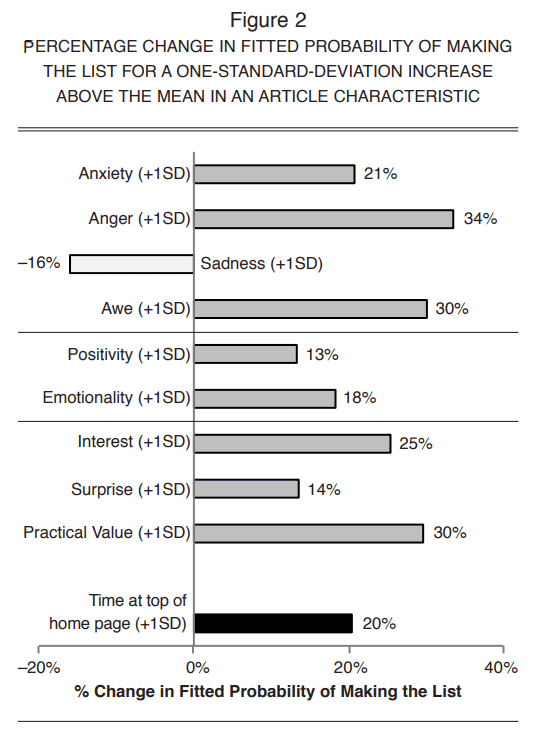
CGP Grey discusses these thought germs, elaborating on this study in a way that’s easy to understand.
The standouts are clear, aren’t they?
- Anxiety
- Anger
- Awe
- Positivity
- Emotionality
- Interest
- Surprise
- Practical value
These all have some impact on virality, all except sadness, which had a deactivating effect.
This sounds confusing.
How does this help you create viral reviews on Facebook?
It’s simple.
Activation gives you an idea of the initiatives you can use to induce virality, provided that you create contagious reviews.
Wait, what?
That’s right. Here are a few examples of these emotions in action and how they can be used in the context of reviews and recommendations.
Anger
These could be reviews where customers are angry with a third party for mishandling their accounts. It can also be a negative review from an unhappy customer who wrote a negative review and then updated their review to five stars.
Here’s an example →
This customer lost their pet, a beloved member of their family. Their vet dropped the ball. This local business dropped the ball. Yet they’ve managed to earn a recommendation from this customer.
How?
By putting the customer and their relationship with them first.
we took our beloved Duke there and then brought him home as he probably would not survive the night. we asked about...
Posted by Julie Heide on Friday, October 23, 2020
Disgust
Disgust in the context of a review outlines how you solved a disgusting problem, experience, or concern for your customers. You’re looking for instances where customers came to you with an unpleasant issue. Your business shouldn’t be the cause of your customer’s disgust, as we see here.
Here’s an example →
Straightforward and simple.
Disgust is a tricky thing. It’s context-specific and needs to be used with care. A review like this in a similar industry could be used in a remarketing campaign to attract more reviews from satisfied customers once the problem has been resolved.
Most disgusting hotel I’ve ever been in my entire life � it was worst than a crack house!!!! I can’t stress enough -...
Posted by Brian Brown on Tuesday, June 12, 2018
Fear
Reviews where customers lead with fears, objections, risk, or loss then show how you’ve helped them recover. “I was afraid they wouldn’t be able to help me… They fixed every one of my problems for less money and in less time.”
Here’s an example →
Dave was afraid.
He had a goal to meet but he was unable to meet his goal on his own. He turned to his personal trainer for help and he was able to meet his goal. When customers bring their fears to you, show them how you’ve helped other customers face and overcome their fears.
I started in December 31 way overweight for my size at 248lbs. My goal was a fitness test I had coming up for the police...
Posted by Dave Smith on Saturday, May 11, 2019
Awe
Reviews where customers share legendary customer service stories. These are stories where you’ve gone above and beyond for your customers.”
Here’s an example →
Couples want their weddings to be picture perfect.
It can be incredibly difficult to exceed your customer’s expectations. Your customers know it too, which is why so many of them are skeptical.
I don’t know why I waited so long to do this but I am so happy I went to wedding shoppe! I went shopping pre-COVID so I...
Posted by Alannah Peters on Monday, September 28, 2020
Positivity
Uplifting, inspirational, or praiseworthy content that’s designed to encourage or motivate others. In the context of reviews, this could be a heartfelt review from a happy customer or a legendary customer service story.
Here’s an example →
This business owner’s newfound purpose strikes a chord with their customers.
Absolutely the BEST experience every!! Our instructor John was hands down PERFECT! The energy and confidence he had...
Posted by Shellida Hancock on Saturday, August 1, 2020
Emotionality
If they’re not your cup of tea, emotional reviews are easy to overlook – a serious mistake. These emotional reviews act as brain germs, transferring enthusiasm and admiration from one customer to another.
Here’s an example →
This business owner’s newfound purpose strikes a chord with their customers.
A Wonderful Country Getaway The Palmquist Farm was a wonderful find! Our hosts, Jim & Helen Palmquist, are warm hearted...
Posted by Marilyn O'Connor on Saturday, March 2, 2019
Interest
These are reviews that convey specific details or information of interest to your customer. It’s heavily dependent on context, and it’s shaped by outside factors like your industry, demographics, psychographics, and more.
Here’s an example →
In this example, this customer has pointed out a few things.
- The name of an all-star employee or proprietor (Hope)
- The relationship and rapport built with customers (what to expect)
- Pictures of the establishment (intangible presentation cues, e.g., cleanliness, decor, style, class, budget, etc.)
I had such an amazing experience at Radiant Bride. Hope was so sweet and picked out a dress I absolutely fell in love...
Posted by Lyndsey Erin on Saturday, September 28, 2019
Surprise
These reviews demonstrate an instance where you’ve done something surprising, unexpected, or novel – from your customer’s standpoint.
Here’s an example →
This family had high expectations, but they were surprised that Palmquist Farm exceeded their expectations.
As of today, there are 66 likes, 5 comments, and 7 shares. Each of these comments from engaged customers shows up in their friend’s feed as well, spreading the word automatically.
We had a beautiful Country Christmas at Palmquist farm. The very first morning after breakfast, Ethan took us to the...
Posted by Jillian Koch Elmhorst on Saturday, December 29, 2018
Practical Value
This content provides prospective customers with practical information to help them with their decision. This information is broad and can include service or product info, social proof, instructions, and answers to frequently asked questions.
Here’s an example →
A few things jump out immediately.
- This customer is delighted.
- She’s impressed with the value they’ve received
- This customer promised to return
- Hotel Brooklyn set the standard for other hotels
Stayed here last night with my 7 year old daughter. Just needed a night away from the madness at the moment. From the...
Posted by Sheri Hallsor on Sunday, October 25, 2020
We’ve seen the impact these emotions can have on customers. Does this help you get more Facebook Recommendations?
Absolutely.
These emotions enable you to engineer Facebook recommendations ahead of time in a way that induces and maximizes virality.
Don’t misunderstand.
I’m not at all suggesting that you coach your customers or tell them what to write in the review. Not only is that unethical it’s far more likely to backfire.
Okay, how do you engineer reviews?
With questions!
How to get Facebook recommendations
Here’s the problem, 70% of your customers will write a review if asked. Why is that a problem? Many local businesses don’t ask customers for reviews. When they ask, they don’t know to ask, so customers are more likely to leave poor quality reviews.
You can decrease your odds of disaster by asking customers the right questions (see step #3).
Here’s an optimization framework you can follow.
Step #1: Provide customers with 10x value
What does it mean to provide your customers with 10x value?
Go over the top.
Your customers paid you for X? You deliver X, Y, and Z. Customers pay for a car wash at your local business? Give them a voucher for 80% off their next visit or a free bonus upgrade (i.e., undercarriage wash). First-timers at your restaurant? Provide your new patrons with a free dessert or complimentary drinks and a voucher for a free meal.
Find a way to give what your competitors can’t or won’t.
Here’s the thing about this – it doesn’t have to be expensive. Contrary to popular belief, you can provide this kind of value cheaply.
- Can't offer discounts or bonuses? Offer 24/7 customer support.
- Can't compete on service? Offer an unbeatable low price guarantee.
- Want to be known as the most expensive option? Provide unbelievable concierge service.
- Raise the performance bar increasing the value and outstanding service you provide to customers.
- Stay on the hunt for opportunities to deliver 10x value to your customers.
Step #2: Identify your ideal reviewers
- Admiration: They have a moderate to strong love or admiration for your business (think Apple followers).
- Engagement: These customers are talkative. They’ll tell you what they think – positive or negative; these customers like, share, comment, and subscribe to your content. They may compliment you consistently or complain to you regularly.
- Relationship: You’ve developed a growing relationship with these customers. There’s rapport, trust, expectation, and commitment, all of the things you need to build a strong relationship.
Step #3: Reach out to your ideal reviewers
It’s time to make your request! If you’ve done the work, you’re ready to reach out to these customers via email, SMS, or phone to request your interview.
Not sure what to say?
Here’s a general template you can customize quickly with specific details for your business. If you’re a long-time reader of the Grade.us blog, you’ll recognize this template.
Hi [Customer Name],
I’m reaching out to our top 3% of customers (you’re one of them).
Would you be willing to answer [6 questions] about our product or service? Should only take 4 or 5 min.
Would it be alright if we talked on the phone? I’m free tomorrow at noon.
[Your Signature]
Are you looking for more ideas and templates you can use? We’ve got you covered. Here’s a long list of templates you can customize.
Step #4: Ask customers the right questions
- What would have prevented you from becoming a customer (or client)?
- What did you find as a result of our service (or product)?
- What did you like most about our service (or product)?
- What would be three other benefits to this service (or product)?
- Would you recommend our business to someone else? Why?
Step #5: Ask customers to review your business
Send customers a copy of the transcribed call.
Ask them to copy and paste their feedback into the review site you’ve directed them to via your review funnel, and viola! You have a review.
Need to handle a large volume of calls? Send customers to a dedicated voicemail inbox, and ask them to share their thoughts. Follow the same steps as before.
If you’re directing customers to Facebook, make sure they know how to recommend your business.
Another option?
Create check-in incentives for customers. This could be as simple as bragging rights (i.e., I’m working out at the gym), a straightforward incentive (Wi-Fi password), discounts, bonuses, or freebies.
Why check-in?
Facebook occasionally sends a reminder out to users to write a recommendation for your business.
If you’re looking for a simple, no-hassle way to request reviews, check-in incentives may be just what you need. Remember that in these cases, you’re not tying a review to an incentive. You’re merely hoping that one leads to another.
One last thing.
It may be a good idea to ask customers to make their recommendations public. Facebook explains why:
“Keep in mind that when someone recommends a business, they can select an audience to share it with. For example, if they post a Recommendation and select Friends as the audience, only their friends can see their Recommendation. Only Recommendations that are shared publicly are included in a Page’s overall rating.”
What if customers prefer not to make their review public?
No problem.
Thank your customers for their thoughtful review and move on. Their review will continue to influence others in their social sphere. If it’s damaging, it’s limited in the amount of damage it can do to your business. Either way, you win!
Okay, you have the review, now what?
How to respond to Facebook recommendations
- Vengeance
- Reducing anger and anxiety
- Seeking advice to fix problems
- Reducing cognitive dissonance
- Helping your company
- Altruism
- Message intrigue
But when do you use these templates?
This is crucial.
Get it wrong, and you can induce virality in the wrong direction.
Not good.
This means you’ll need to use the right review template, on the right reviewers, at the right time.
Here are some important best practices you should follow.
- Are reviewers fair, balanced, and objective in their review? Thank them for their response and allow them to speak their piece without interrupting or interjecting. It doesn't matter if their recommendation is positive or negative.
- Are reviewers unhappy or misguided customers? Listen, empathize and if necessary, gently share the facts to correct any misperceptions. When in doubt, own ambiguous mistakes.
- Are your reviewers trolls, ragers, or sadists? These are bad faith reviews, do not engage. Monitor their feedback, interjecting with comments to clarify any obvious untruths (i.e., we don't sell X product, never have).
Additionally, you’ll want to make sure that you…
- Avoid incentivizing customers for a review.
- Always respond to good faith reviews (good or bad); it extends your organic reach and shows customers that you care. Ignoring is often perceived as stonewalling.
- Avoid criticizing or bad-mouthing reviewers. Avoid a tone of defensiveness or contempt.
- Report or flag reviews that violate Facebook’s terms of service or recommendation guidelines. Flag recommendations from profiles that seem to be spammy or suspect.
- Own and acknowledge any mistakes, but avoid getting yourself into legal hot water.
- Provide customers with contact information, so you’re able to continue to conversation privately offline.
If you’re not sure how to respond to a specific remark from customers, keep this simple axiom in mind.
Always take the high road.
Be timely, cite your sources (or provide evidence), be transparent, and strike the right (kind) tone. There’s a very good chance your customer’s friends and family can see the conversation taking place. Be kind, be helpful, or be gone.
How should you respond?
Should you respond as a business or as an individual on behalf of your company?
Responding as a business
Pros
- Customers/reviewers know they're speaking with an employee on an official channel.
- It's easier for employees to respond on the company's behalf.
- Lurkers and observers view and understand your response as 'official.'
Cons
- Review responses may be viewed as impersonal and 'corporate.'
- Reviewers aren't sure who to approach if they need specific one-on-one help.
Responding as an individual
Pros
- Review responses are personalized.
- One-on-one responses mean customers may be more willing to talk.
- It's easier to turn a negative experience into a positive one.
Cons
- Reviewers may not be familiar with the individual profiles of your team.
- Individual reviews may create problems if employees leave.
Ultimately, you’ll need to weigh the pros and cons to decide which option is best for you. One compromise would be to reply using your official Facebook page but have individual employees sign their name at the end of their response.
How to market your Facebook recommendations
It’s time to market your Facebook recommendations; where do you start? Earlier in this post, I mentioned the importance of cold, warm and hot traffic, remember?
No?
Here’s a quick recap.
“The majority of sellers on Facebook are inexperienced and subject to Facebook’s inexperience tax. They treat lead gen as a direct response affair when it’s actually more similar to a CPM model. Customers on Facebook need to be wooed. The direct approach is typically not the most effective approach.”
How do you promote your Facebook recommendations using Ads?
You use 60/30/10.
Here’s how it works.
You spend…
- 10% of your ad budget on Cold traffic. You promote your content to highly targeted groups of prospects who have never heard of you. You provide them with value in the form of a tool, quiz, download, or content. No opt-in required. If you're going to lose money in your campaign, you lose it here to gain valuable insights everywhere else.
- 30% of your ad budget on Warm traffic. The prospects above who have opted in are now (a.) warm – they're familiar with your business and (b.) interested enough in your offer to continue the conversation. This is the relationship-building phase of your campaign.
- 60% of your ad budget on Hot traffic. These are the prospects who have opted-in, converted, and/or engaged with your business. They're email subscribers, Facebook fans, they've purchased a tripwire, etc. These prospects have self-identified, showing a clear interest in your product or service.
- One for prospects who aren’t customers yet, but they want to see a strong review portfolio.
- One for existing customers who are primed and ready for you to request a review.
- Cold traffic = customers you’ve sent review requests out to; the vast majority of your current or active customers should fit in this category.
- Warm traffic = pending review requests (e.g., customers setting a time to chat, reviews are in-progress, etc.). Some customers will fall out of your funnel at this stage; it’s okay. You can add them to your follow-up campaigns or reach out again at the next triggering event.
- Hot traffic = customers who have completed their review but haven’t posted their review yet.
Your Facebook recommendations (reviews) are multi-purpose tools that boost conversions throughout your funnel.
- Your Facebook recommendations convert top and middle of funnel prospects.
- These Facebook recommendations are prime prospects, later on, increasing the odds that they'll write a review if asked.
- Your Facebook recommendations are helpful tools you can embed on decision pages (opt-in, sales, and content pages).
- Each Facebook recommendation, if public, can be shared by employees, customers, friends of customers, prospects, and publicly in blog posts, forums (i.e., Reddit), and Facebook groups, via messenger and as a direct selling tool for direct sales teams.
- Facebook recommendations (as advertisements) can be used as social proof, further motivating now converted customers to share their reviews.
- Recently shared reviews convert top and middle of funnel prospects.
What are some other ways to market your ads?
Share your reviews on your feed.
You’ll want to direct visitors to your review tab, where they can read through the reviews they’ve received on their own. You can boost these posts and share them with a custom audience, or you can link to them directly.
You can embed your recommendations.
It’s easy to embed your Facebook recommendations; here’s how you do it.
- Head to your Facebook Page.
- Find the recommendation you’d like to embed.
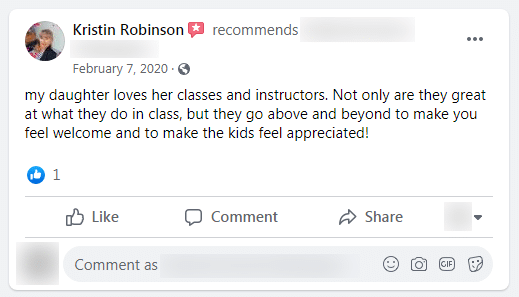
- Click the three dots on the top right of the recommendation, then select ‘Embed.’
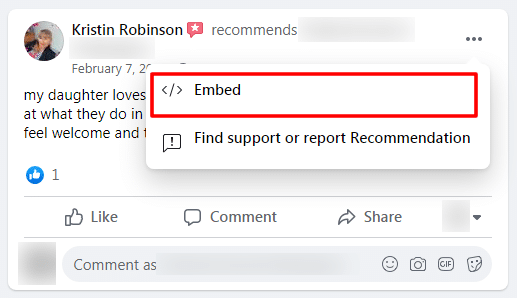
- Click the ‘Get Code‘ button, then follow the instructions to copy and paste the code from your recommendation into your website.
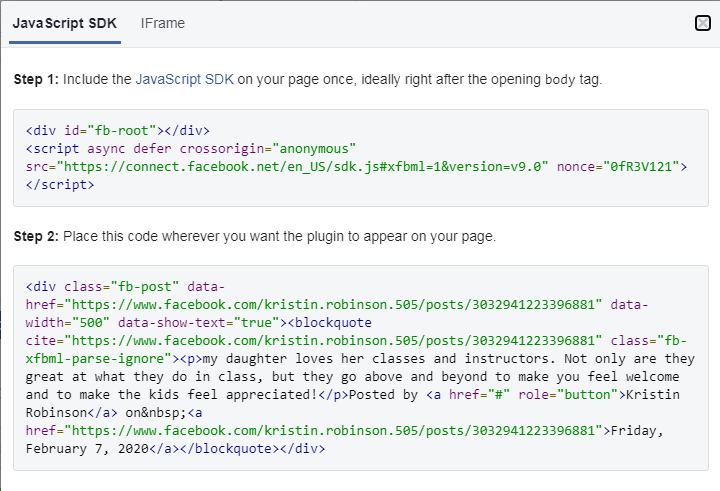
What about sharing Facebook Recommendations via email?
- Head over to Facebook.
- Find the recommendation you'd like to share.
- Click on the time and date of the post to open in a new window.
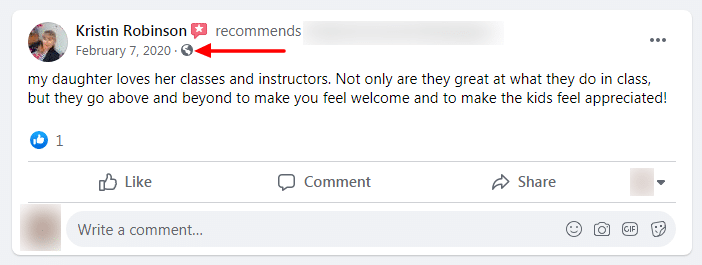
- Copy the quote you'd like to share and link.
- Next, copy the URL from your browser, paste it into your email as a quote, or link it to the image.
It’s pretty easy, right?
Here’s the best part. Aside from reporting Facebook recommendations for inappropriate content, there’s not much in the way of rules or regulations. Facebook shares a list of do’s and don’ts on their policies pages, but it’s not particularly clear what Facebook finds acceptable or unacceptable when it comes to Facebook Recommendations.
What does this mean?
You’ll want to ensure you’re fully compliant with their Terms of Service, Policies, and Community Standards. Follow the rules you have to the best of your ability. If it seems unethical or questionable, don’t do it.
Facebook recommendations are an opportunity
Facebook recommendations trigger growth.
Most brands use Facebook recommendations accidentally – their customers take the initiative, posting recommendations on their own. For most, it’s a consumer-driven phenomenon.
The results are sporadic and messy.
It doesn’t have to be that way for you. With the right approach, your positive recommendations can be brand-driven. With the right tactics, you can boost the traffic, leads, and sales flowing to your business.
But only if you work with Facebook’s platform.
Each of your customers is a node in a network. This gives you instant access to almost a billion people, customers who are reliant on Facebook for person-to-person reviews and recommendations.
Can your reviews be viral?
They can be with the right framework. You can attract the kind of customer attention and conversions your local business needs to grow exponentially, one recommendation at a time.

